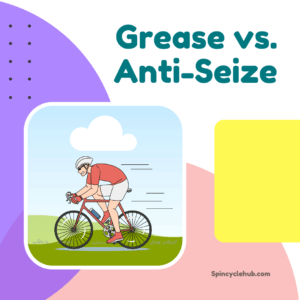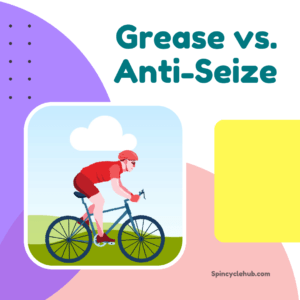Introduction
Lubrication plays a crucial role in maintaining the smooth operation of various mechanical systems. When it comes to choosing the right lubricant, two popular contenders often come to mind: grease and anti-seize. Whether you’re a DIY enthusiast, an automotive aficionado, or an industrial worker, understanding the differences between grease and anti-seize can help you make informed decisions. In this article, we’ll dive into the world of lubricants and compare the properties, applications, and benefits of grease and anti-seize. So, let’s roll up our sleeves and explore the battle of grease versus anti-seize!
1. What’s the Deal with Grease?
The Basics of Grease
Grease, in its essence, is a thick and semi-solid lubricant. It consists of a mixture of oil, thickeners, and additives. This unique composition allows grease to adhere to surfaces, providing long-lasting lubrication and protection against friction and wear. Think of it as a viscous superhero that keeps your machinery running smoothly.

Grease Applications
Grease finds its home in a wide range of applications. In the automotive industry, it’s commonly used for wheel bearings, chassis fittings, and universal joints. Industrial machinery relies on grease for gears, chains, and bearings. Even in our everyday lives, grease comes to the rescue when it comes to lubricating door hinges, locks, and other household items.
Pros of Grease
Grease brings several advantages to the table. Firstly, it provides long-lasting lubrication, reducing the need for frequent reapplication. Additionally, grease exhibits resistance to water and contaminants, ensuring reliable performance even in challenging environments. Moreover, it can withstand high temperatures and pressure, making it ideal for heavy-duty applications. Lastly, grease helps prevent corrosion and rust, extending the lifespan of the lubricated components.
Drawbacks of Grease
While grease is a versatile lubricant, it does have a few drawbacks. One challenge is the difficulty in cleaning and removing grease once applied. Additionally, grease has a tendency to attract dirt and dust, which can lead to increased wear over time. It’s also worth noting that grease may not be suitable for certain materials or high-speed situations, as it can cause excessive drag or overheating.
2. Anti-Seize: A Different Approach to Lubrication
What is Anti-Seize?
Anti-seize, on the other hand, takes a slightly different approach to lubrication. It is a compound specifically formulated to prevent seizing, galling, and corrosion between metal parts. Anti-seize is typically composed of a lubricating agent, such as graphite or copper, mixed with a base material, such as grease or oil.
Anti-Seize Applications
Anti-seize finds its niche in various applications. In the automotive industry, it’s commonly used on spark plugs, exhaust systems, and brake caliper bolts. The marine industry also relies on anti-seize to combat corrosion in saltwater environments. Furthermore, anti-seize is beneficial for plumbing and pipe fittings, ensuring easy disassembly and preventing thread damage.
Benefits of Anti-Seize
One of the key benefits of anti-seize is its ability to prevent corrosion and seizing of metal parts, even under extreme conditions. It facilitates the disassembly and removal of components that are prone to sticking, saving time and effort during maintenance. Additionally, anti-seize provides effective lubrication in high-temperature environments and exhibits compatibility with various materials, including stainless steel, aluminum, and copper.
Drawbacks of Anti-Seize
Despite its advantages, anti-seize does come with a few drawbacks. One common challenge is the messy application process, as the compound tends to leave visible marks. Additionally, certain situations, such as dust or debris exposure, may lead to contamination of the anti-seize compound. Lastly, in low-speed situations, the lubricating properties of anti-seize may not be as effective, making it less suitable for applications that require frequent movement.
3. Grease vs. Anti-Seize: When to Use Which?
Choosing between grease and anti-seize depends on several factors. Consider the temperature, speed, and material compatibility requirements of your specific application. For components that require long-lasting lubrication and protection against wear, grease is the go-to choice. On the other hand, if you’re dealing with metal parts that are prone to seizing, galling, or corrosion, anti-seize is the preferred option.
For example, when greasing wheel bearings in a car, grease provides the necessary lubrication and protection. However, when it comes to spark plugs, applying anti-seize can prevent them from sticking in the engine block.
Conclusion
In the world of lubrication, grease and anti-seize play distinct roles. Grease excels in providing long-lasting lubrication and protection against wear, while anti-seize focuses on preventing seizing and corrosion between metal parts. By understanding the properties, applications, benefits, and drawbacks of both lubricants, you can make informed decisions and ensure the optimal performance and longevity of your mechanical systems.

FAQs
FAQ 1: Can I use grease instead of anti-seize?
While grease offers lubrication, it may not provide the necessary protection against seizing and corrosion. It’s best to use anti-seize in applications that require those specific properties.
FAQ 2: Can anti-seize be used on plastic parts?
Anti-seize is primarily designed for metal-to-metal contact. It may not be suitable for use on plastic parts, as it can cause damage or deterioration. Always refer to the manufacturer’s guidelines for compatibility.
FAQ 3: How often should I reapply grease or anti-seize?
The frequency of reapplication depends on factors such as usage, environmental conditions, and manufacturer recommendations. Regular inspection and maintenance will help determine when reapplication is necessary.
FAQ 4: Can I mix different types of grease or anti-seize?
Mixing different types of grease or anti-seize compounds is generally not recommended. It can result in unpredictable performance and may compromise the effectiveness of the lubricants. Stick to using a single type for each application.
FAQ 5: Is it necessary to clean surfaces before applying grease or anti-seize?
Yes, it’s crucial to clean surfaces thoroughly before applying grease or anti-seize. Removing dirt, debris, and old lubricant ensures better adhesion and optimal performance of the lubricants.
- Understanding the Differences Between Grease and Anti-Seize: This article dives deeper into the distinctions between grease and anti-seize, highlighting their properties, applications, and key considerations when choosing between the two lubricants.
- When to Use Grease or Anti-Seize: A Practical Guide: This guide provides practical insights into when to use grease or anti-seize based on different scenarios and applications. It offers tips and recommendations to help readers make informed decisions.
Watch this one,
Video Credits – Project Farm
DOWNLOAD THIS ARTICLE :Click Here
You May Also Like
-
Mastering the Watts: A Guide to Boosting Your FTP from 200 to 300
-
Breaking the Silence on Disc Brakes: Unveiling Their True Stopping Power
-
Industry Nine Hub Problems: Unraveling the Challenges of a Beloved Component



